What's New
Displaying results 4781 - 4790 of 4922

Resource | Publications,
The proposed generic reporting format is meant to assist National AIDS Councils (or equivalent) in drafting their national report to be submitted to the UN General Assembly on biennial basis as a follow-up to the Declaration of Commitment (DoC) signed in June 2001 at the UNGASS on HIV/AIDS.

Resource | Publications,
UNICEF Headquarters has collected data on Lifeskills education through schools in about 40 countries (including some large States) which is to be used as a baseline to monitor progress toward the UNICEF Medium Term Strategic Priorities (MTSP). Some countries in the East Asia and the Pacific Region are included in the specific targets for MTSP, while others, although not specifically targeted, need to monitor their progress toward MTSP, the Millenium Development Goals (MDG), and World Fit for Children (WFFC) targets.
In order to get a clearer picture of the status of Lifeskills-based education in the East Asia and Pacific region, the monitoring tool that was developed by headquarters was applied to the information provided in the Country Office Annual Reports for 2002.
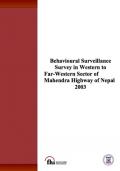
Resource | Publications,
Behavioural Surveillance Survey (BSS) is based on classical HIV and STI serologic surveillance methods, BSS consists of repeated cross-sectional surveys of groups where behaviour may help explain the spread of HIV and determine prevention needs in a given country. The method uses a consistent sampling methodology, consistent data collection methods and consistent indicators in order to track trends in behaviour over time.
This survey is the first round of the BSS conducted in western to far-western sector of the Mahendra highway route of FHI project area.
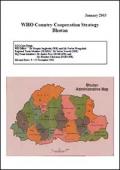
Resource | Publications,
This WHO Country Cooperation Strategy (CCS) outlines the strategic framework for the WHO's work in Bhutan for the period end 2002 - end 2007.
The CCS is an attempt to articulate a coherent vision and selective priorities for collaboration between WHO and Bhutan. It is based on a systematic assessment of recent national achievements in health care, the current and emerging health needs and development challenges; the policies and expectations of the Government; and the activities of other development partners.

Resource | Publications,
This intervention-linked research aimed to (1) rapidly reduce the prevalence of common curable STIs in Angeles City and (2) maintain STI reductions over time.
Significant reductions in prevalence of common curable STIs are possible when effective interventions reach core groups such as sex workers. In Angeles City, a single round of presumptive antibiotic treatment had a short-term impact on STI prevalence that was proportional to coverage. Longer-term maintenance of STI control requires establishment of effective preventive and curative service.

Resource | Publications,
China is a country with an overall low HIV prevalence and concentrated epidemic in focused areas and focused groups of people. Therefore, as recommended, we use the alternative indicator – HIV prevalence among sex workers (CSW), injecting drug users (IDU), and STI attendees, instead of the core indicator - percentage of young people aged 15-24 who are HIV-infected.
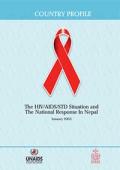
Resource | Publications,
Over the last years the HIV/AIDS epidemic in Nepal has gained ground, and Nepal has progressed from a "low prevalence" country to one with a so-called "concentrated" epidemic in certain sub-groups of the population. For Nepal the window of opportunity is closing fast to effectively address the epidemic. Without mounting a vigorous, broad-based response now, AIDS may become the leading cause of death in the age group 15-49 years over the next ten years.
The aim of the "The HIV/AIDS/STD Situation and the National Response in Nepal" booklet is to give an overview of the situation and the response to HIV/AIDS in Nepal, and to touch on priorities and challenges. This publication is jointly published by the National Centre for AIDS and STD Control (NCASC), and the United Nations Theme Group on HIV/AIDS in Nepal.
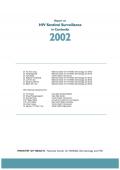
Resource | Publications,
The ultimate goal of second generation surveillance is to prove information of relevance to policymakers for public health section. HIV surveillance systems help countries find track HIV infection, both in term of geographic location and key populations affected.
The 2002 round of HIV Sentinel Surveillance (HSS) is the eighth in a series of annual surveys that have taken place in Cambodia beginning in 1994 (no data were collected for the year 2001.
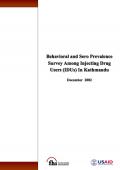
Resource | Publications,
Injecting drug users function as a “bridging population” for HIV transmission between a core HIV risk group and general population. The main objective of this study is to estimate the prevalent rates of HIV among IDUs and assess their role in the transmission of HIV. The study was conducted in four municipalities of Kathmandu, Lalitpur and Bhaktapur districts. Three-hundred and three male IDUs were sampled from 20 different randomly selected sites, through respondent-driven sampling (RDS). In Kathmandu, fifty-seven females were sampled randomly instead of using the RDS method.
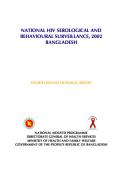
Resource | Publications,
HIV prevalence is monitored annually among specific groups at sentinel sites spread across Bangladesh. Behaviours that carry a risk of HIV infection are evaluated in tandem. Syphilis and hepatitis are also monitored as surrogate markers to corroborate behavioural data regarding unprotected sex and unsafe injections.
This report presents the findings and conclusions from the fourth round of national HIV serological and behavioural surveillance that was conducted in 2002. The information obtained can serve as a tool to inform programme policy and interventions, to advocate for increased resources and investment in prevention, aid in targeting interventions, and in measuring their progress and impact.





